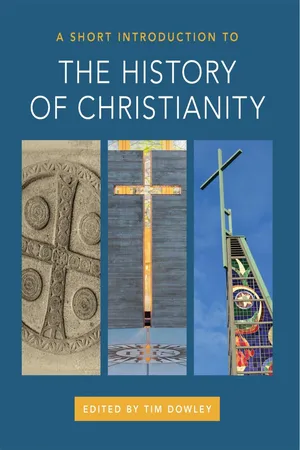
- 432 pages
- English
- ePUB (mobile friendly)
- Available on iOS & Android
A Short Introduction to the History of Christianity
About this book
Tim Dowley's masterful one-volume survey of church history is now available in a new concise format designed with today's student in mind. Each section of Dowley's Introduction to the History of Christianity has been reviewed and content edited to create a more compact summary of Christian history. This new, shorter introduction retains the full-color format of the popular full edition, including the third edition's new images and maps.
Dowley has assembled a global cast of respected scholars to write the full story of the rise of the Christian faith and to provide a rounded picture of the worldwide development of Christianity. The volume has been praised as accurate, scholarly, and balanced. Its writers are committed to Christianity but also to the unhindered pursuit of truth that does not avoid the darker aspects of the varied story of Christianity.
The accessible text is supported by detailed timelines, maps, profiles of key figures in Christianity, colorful images, and a complete glossary. Each section includes questions for discussion.
Frequently asked questions
- Essential is ideal for learners and professionals who enjoy exploring a wide range of subjects. Access the Essential Library with 800,000+ trusted titles and best-sellers across business, personal growth, and the humanities. Includes unlimited reading time and Standard Read Aloud voice.
- Complete: Perfect for advanced learners and researchers needing full, unrestricted access. Unlock 1.4M+ books across hundreds of subjects, including academic and specialized titles. The Complete Plan also includes advanced features like Premium Read Aloud and Research Assistant.
Please note we cannot support devices running on iOS 13 and Android 7 or earlier. Learn more about using the app.
Information
1
BEGINNINGS
AD 1–325
SUMMARY
CHAPTER 1
The Church Begins: From Jerusalem to Rome
THE BIRTH OF THE CHURCH


THE JERUSALEM CHRISTIANS
PERSECUTION AND EXPANSION
| PETER Peter came from Bethsaida, on Lake Galilee, and his fisherman father John originally named him Simon. He was living in Capernaum, with his wife, brother, and mother-in-law, when first introduced to Jesus by his brother Andrew. He quickly became the leader of Jesus’ twelve close followers, was often their spokesman, and was the first to declare publicly that Jesus was the Messiah, at Caesarea Philippi. Jesus gave him the nickname ‘Peter’ (Cephas in Aramaic) meaning ‘rock’. Rash and hot-blooded, Peter said that he was ready to die with Jesus, then three times denied knowing him on the night of Jesus’ arrest. But Peter was one of the first to meet the risen Jesus, who specifically restored him to his position as leader. After Jesus ascended, Peter took the initiative in the appointment of a successor to Judas among the Twelve, and was the chief preacher when the Holy Spirit came, on the Day of Pentecost. Peter and John took the lead in the early days of the church, disciplining Ananias and Sapphira after they deceived the believers, healing and preaching, and taking a special interest in the mission to Samaria. Peter’s mission Later, Peter had a vision which launched the mission to take the gospel to the Gentiles. Although he was wary of this new venture, and later wavered under the criticism of strict Jewish Christians at Antioch, Peter welcomed Paul’s work among the Gentiles, and gave it his full support at the Council of Jerusalem, which welcomed Gentile converts without imposing on them all the rigours of the Jewish law. Peter was imprisoned by King Herod Agrippa I (r. AD 41–44), but miraculously escaped the night before he was due to be executed. Peter’s later career is obscure. He may have worked in Asia Minor, perhaps visited Corinth, but ultimately settled in Rome, where he described himself as a ‘fellow elder’, which may mean that he was one of the church leaders, but not the sole leader. Two New Testament letters bear his name, and he was probably the main source for Mark’s Gospel. Peter is believed to have been martyred at Rome during Nero’s persecution of Christians, around AD 64. Although he did not found the church at Rome, Peter’s martyrdom in Rome gave it great prestige. Paul’s association with the church added to this, and the Church of... |
Table of contents
- Cover
- Title Page
- Copyright
- Table Of Contents
- Contributors
- List of Maps
- List of Time Charts
- List of Illustrations
- Preface
- Preface to the Third Edition
- BEGINNINGS: AD 1–325
- ACCEPTANCE AND CONQUEST: AD 325–600
- A CHRISTIAN SOCIETY: AD 600–1500
- REFORM AND RENEWAL: 1500–1650
- REASON, REVIVAL, AND REVOLUTION: 1650–1789
- CITIES AND EMPIRES: 1789–1914
- A CENTURY OF CONFLICT: 1914–2001
- EPILOGUE: A NEW MILLENNIUM
- Further Resources on the History of Christianity
- Glossary
- Index
- Picture Acknowledgments